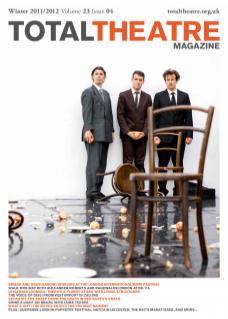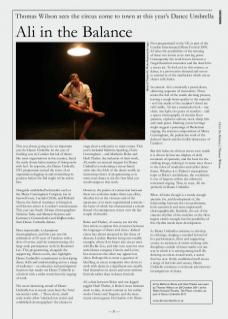This was always going to be an important year for Dance Umbrella. In the year of funding cuts the London festival of dance, like most organisations in the country, faced the eerily doom-laden mantra of ‘doing more with less’. In response, the Dance Umbrella 2011 programme carried the sense of an organisation digging-in and retrenching its position before the full might of the storm hits.
Alongside established behemoths such as the Merce Cunningham Company (on its farewell tour), Lucinda Childs, and Richard Alston, the festival continues to bring less well-known artists to London’s consciousness. This year saw South African choreographers Nelisiwe Xaba and Mamela Nyamza and Germany’s Gintersdorfer and Klaβen make their Dance Umbrella debuts.
More importantly it champions choreographers, and this year saw the celebration of 20 years of Candoco with a slew of events, and the commissioning of a large-scale participatory work by Rosemary Lee. This programming, alongside the supporting Alston events, also highlights Dance Umbrella’s commitment to developing dance skills and understanding across a range of audiences – an educative and participatory function that marks out Dance Umbrella as a festival with a wider remit than the staging of work.
The most interesting strand of Dance Umbrella has in recent years been the ‘brief encounters with….’ These short, smallscale works allow ‘talented new artists and established choreographers’ the chance to stage short works prior to main events. This year’s included Matthias Sperling, Claire Cunningham – and Mathurin Bolze and Hedi Thabet: the inclusion of their work, Ali, marks an unusual tangent for Dance Umbrella in welcoming a circus-based artist into the folds of the dance world; an interesting choice of programming as in some ways dance is not the first label you would assign to this work.
However, the points of connection between these two artforms makes them easy allies, whether it is at the virtuoso end of the spectrum, or in more experimental contexts – the latter of which has characterised a certain thread of contemporary circus over the last couple of decades.
Bolze and Thabet, of course, are not the first artists to explore this crossover between the languages of dance and circus. Indeed circus has always attracted its fair share of dancers, Lindsey Butcher being one notable example, whose first forays into circus were with Ra-Ra Zoo, and who now runs her own aerial dance company Gravity and Levity; but crossovers the other way appear less often. Perhaps this is more a question of labelling, as circus companies who chose to work with dance in a significant way usually find themselves in circus and cross-artform festivals rather than in dance festivals.
Ali, a duet between Bolze and one-legged juggler Hedi Thabet, is Bolze’s most intimate work to date, in stark contrast to his earlier works Fenetres and Tangentes, and the more recent extravaganza Du Goudron et des Plumes. First programmed in the UK as part of the London International Mime Festival 2009, Ali takes the possibilities of the meeting of these two artists as its starting point. Consequently the work hovers between a frugal theatrical encounter and the sketch for a circus act. To look at it in this context, as dance, is a provocative demand and serves to remind us of the similarities which circus shares with dance.
In content Ali is essentially a pared-down, skittering sequence of encounters. These retain the feel of the studio devising process, leaving a rough-hewn quality to the material – as if the marks of the sculptor’s chisel are still visible. Ali has a minimalist look – one chair, one light, two pairs of crutches – and a sparse choreography of circular floor patterns, explosive actions, razor-sharp lifts and stark poses. Marking out its heritage might suggest a parentage of Beckettian staging, the staccato compositions of Merce Cunningham, the pedestrian work of the Judson Church and the bodily-democracy of Candoco.
But this belies its obvious circus root: inside it is driven by bravura displays of skill, moments of spectacle, and the hunt for the striking image, making it in many ways closer to the ethos of modernist and earlier dance forms. Whether it is Thabet’s stratospheric leaps or Bolze’s acrobalance, the vocabulary is one of largesse within the otherwise restrained staging. Thus, in ways, Ali sits perfectly in Dance Umbrella.
What Ali lacks though is a sturdy enough premise for, and development of, the relationship between the two performers, both narratively and more importantly choreographically. Similarly, the use of the staccato rhythm of the crutches on the floor begins clearly enough, but the possibility of this rhythm needs more development.
As Dance Umbrella continues to develop its offerings, shaping a rounded festival of live performances, films and supporting events, its inclusion of artists working with disciplines outside of dance marks out one way in which it is reinvigorating itself. By drawing on circus-rooted work, a sector that has now firmly established itself across a range of festivals and venues, Dance Umbrella continues to welcome adventurous investigations of dance.
Ali by Mathurin Bolze and Hedi Thabet was seen by Thomas Wilson on 29 October 2011 at the Robin Howard Theatre, The Place, London, as part of Dance Umbrella 2011. www.danceumbrella.co.uk

